JL_X_NSPM1_30
RSP 11476
Grower: Kevin McKernan
General Information
- Accession Date
- May 7, 2020
- Reported Plant Sex
- Male
- Report Type
- StrainSEEK v2 3.2Mb
- DNA Extracted From
- Stem
The strain rarity visualization shows how distant the strain is from the other cultivars in the Kannapedia database. The y-axis represents genetic distance, getting farther as you go up. The width of the visualization at any position along the y-axis shows how many strains there are in the database at that genetic distance. So, a common strain will have a more bottom-heavy shape, while uncommon and rare cultivars will have a visualization that is generally shifted towards the top.
Chemical Information
Cannabinoid and terpenoid information provided by the grower.
Cannabinoids
No information provided.
Terpenoids
No information provided.
Genetic Information
- Plant Type
- Type II
File Downloads
The bell curve in the heterozygosity visualization shows the distribution of heterozygosity levels for cannabis cultivars in the Kannapedia database. The green line shows where this particular strain fits within the distribution. Heterozygosity is associated with heterosis (aka hybrid vigor) but also leads to the production of more variable offspring. When plants have two genetically different parents, heterozygosity levels will be higher than if it has been inbred or backcrossed repeatedly.
The ratio of reads mapped to Y-contigs to reads mapped to the whole Cannabis genome (Y-ratios) has been demonstrated to be strongly correlated with plant sex typing. This plot shows the distribution of Y-ratios for all samples in our database which were sequenced with the same method (panel or WGS) as this sample and where this sample falls in the distribution.
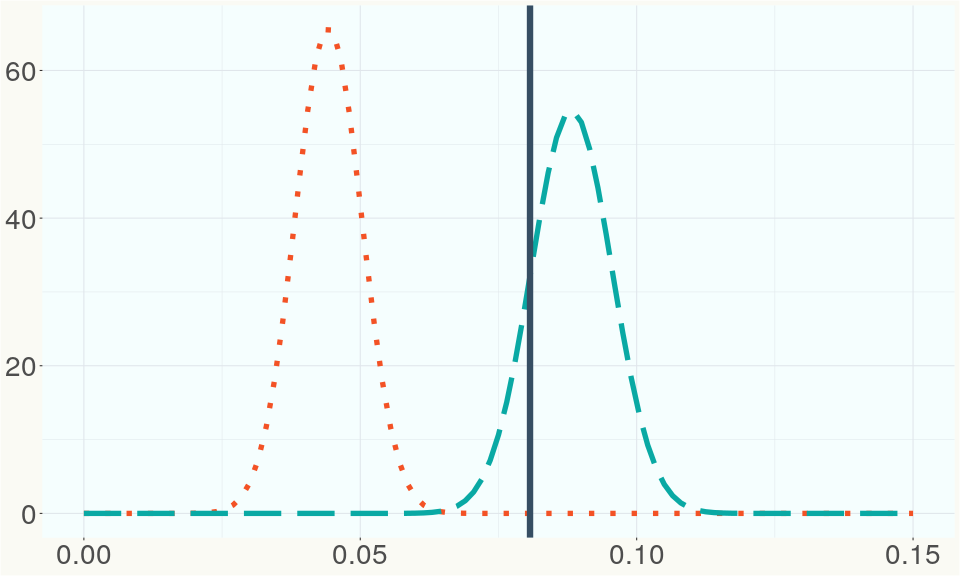
This chart represents the Illumina sequence coverage over the Bt/Bd allele. These are the three regions in the cannabis genome that impact THCA, CBDA, CBGA production. Coverage over the Active CBDAS gene is highly correlated with Type II and Type III plants as described by Etienne de Meijer. Coverage over the THCA gene is highly correlated with Type I and Type II plants but is anti-correlated with Type III plants. Type I plants require coverage over the inactive CBDA loci and no coverage over the Active CBDA gene. Lack of coverage over the Active CBDA and Active THCA allele are presumed to be Type IV plants (CBGA dominant). While deletions of entire THCAS and CBDAS genes are the most common Bt:Bd alleles observed, it is possible to have plants with these genes where functional expression of the enzyme is disrupted by deactivating point mutations (Kojoma et al. 2006).
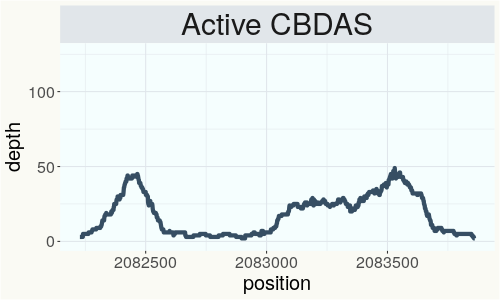
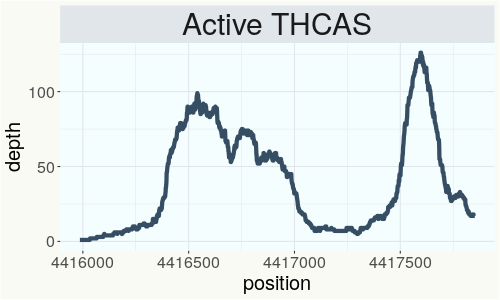
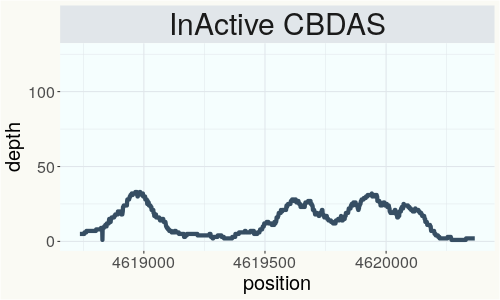
This chart represents the Illumina sequence coverage over the CBCA synthase gene.
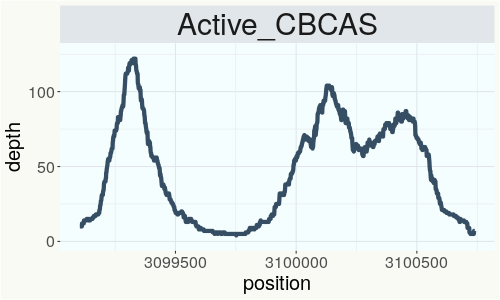
Variants (THCAS, CBDAS, and CBCAS)
No variants to report
Variants (Select Genes of Interest)
| PKSG-2a | c.241G>A | p.Val81Met | missense variant | moderate | contig700 | 1945149 | C/T |
|
| PKSG-2a | c.240T>G | p.Asp80Glu | missense variant | moderate | contig700 | 1945150 | A/C |
|
| PKSG-2a | c.230T>C | p.Val77Ala | missense variant | moderate | contig700 | 1945160 | A/G |
|
| PKSG-2a | c.67T>A | p.Phe23Ile | missense variant | moderate | contig700 | 1945567 | A/T | |
| PKSG-2a | c.31A>T | p.Thr11Ser | missense variant | moderate | contig700 | 1945603 | T/A | |
| PKSG-2b | c.1152T>A | p.Asn384Lys | missense variant | moderate | contig700 | 1950486 | A/T | |
| PKSG-2b | c.1132C>G | p.Leu378Val | missense variant | moderate | contig700 | 1950506 | G/C |
|
| PKSG-2b | c.1117A>G | p.Ile373Val | missense variant | moderate | contig700 | 1950521 | T/C | |
| PKSG-2b | c.774G>A | p.Met258Ile | missense variant | moderate | contig700 | 1950864 | C/T | |
| PKSG-2b | c.241G>A | p.Val81Met | missense variant | moderate | contig700 | 1951397 | C/T |
|
| PKSG-2b | c.240T>G | p.Asp80Glu | missense variant | moderate | contig700 | 1951398 | A/C |
|
| PKSG-2b | c.230T>C | p.Val77Ala | missense variant | moderate | contig700 | 1951408 | A/G | |
| PKSG-2b | c.224A>G | p.Lys75Arg | missense variant | moderate | contig700 | 1951414 | T/C | |
| PKSG-2b | c.188T>G | p.Ile63Ser | missense variant | moderate | contig700 | 1951450 | A/C |
|
| PKSG-2b | c.187A>T | p.Ile63Phe | missense variant | moderate | contig700 | 1951451 | T/A |
|
| PKSG-2b | c.167C>G | p.Thr56Ser | missense variant | moderate | contig700 | 1951471 | G/C | |
| PKSG-2b | c.31A>T | p.Thr11Ser | missense variant | moderate | contig700 | 1951851 | T/A | |
| DXR-2 | c.1319T>C | p.Ile440Thr | missense variant | moderate | contig380 | 285250 | A/G |
|
| DXR-2 | c.431C>G | p.Ala144Gly | missense variant | moderate | contig380 | 287760 | G/C | |
| aPT4 | c.97T>C | p.Tyr33His | missense variant | moderate | contig121 | 2828753 | T/C |
|
| aPT4 |
c.235_236del |
p.Val79fs | frameshift variant | high | contig121 | 2829030 | ATG/A |
|
| aPT4 | c.238delT | p.Ser80fs | frameshift variant | high | contig121 | 2829034 | AT/A |
|
| aPT4 | c.1168T>C | p.Tyr390His | missense variant | moderate | contig121 | 2833503 | T/C |
|
| aPT1 |
c.95_97delGT |
p.Cys32del | disruptive inframe deletion | moderate | contig121 | 2835800 | ATGT/A | |
| aPT1 | c.406A>G | p.Ile136Val | missense variant | moderate | contig121 | 2839605 | A/G | |
| HDS-2 |
c.82_93delGT |
p.Val28_Thr3 |
conservative inframe deletion | moderate | contig95 | 1989748 |
CGTAACCGGAAC |
|
| HDS-2 | c.127T>G | p.Ser43Ala | missense variant | moderate | contig95 | 1989794 | T/G |
|
Nearest genetic relatives (All Samples)
- 0.046 JL X NSPM1 22 (RSP11475)
- 0.071 JL X NSPM1 21 (RSP11474)
- 0.076 JL X NSPM1 5 (RSP11467)
- 0.081 JL x NSPM1 1 (RSP11478)
- 0.082 JL Cross 22 (RSP11523)
- 0.086 JL Tent 1 yellow stake (RSP11488)
- 0.086 JL Cross 17 (RSP11518)
- 0.086 JL X NSPM1 14 (RSP11473)
- 0.089 JL Cross 23 (RSP11524)
- 0.094 JL X NSPM1 33 (RSP11477)
- 0.097 JL Cross 9 (RSP11510)
- 0.097 JL x NSPM1 3 (RSP11481)
- 0.100 JL Tent 4 (RSP11491)
- 0.100 JL X NSPM1 6 (RSP11468)
- 0.105 JL Cross 19 (RSP11520)
- 0.108 JL Cross 18 (RSP11519)
- 0.116 JL X NSPM1 7 (RSP11469)
- 0.117 JL Cross 28 (RSP11529)
- 0.121 JL Cross 2 (RSP11503)
- 0.124 JL Tent 2 (RSP11489)
Most genetically distant strains (All Samples)
- 0.484 80E (RSP11213)
- 0.462 Cbot-2019-005 (RSP11133)
- 0.453 80E (RSP11211)
- 0.451 80E (RSP11212)
- 0.445 Northern Lights (RSP11501)
- 0.435 CS (RSP11208)
- 0.429 R1in136 (SRR14708226)
- 0.424 Cherry Blossom (RSP11323)
- 0.423 Ruderalis Indica (SRR14708267)
- 0.421 Carmagnola (RSP11202)
- 0.421 Carmaleonte (RSP11207)
- 0.420 IUP3 (SRR14708256)
- 0.419 XBL1 (SRR14708207)
- 0.419 R1in136 (SRR14708237)
- 0.418 Kush Hemp E1 (RSP11128)
- 0.418 R1in136 (SRR14708227)
- 0.417 Carmagnola (RSP10980)
- 0.415 Tanao Sri -46- (RSP11486)
- 0.415 Arcata Trainwreck (RSP11176)
- 0.413 Tanao Sri-white -80- (RSP11621)
Nearest genetic relative in Phylos dataset
- Overlapping SNPs:
- 67
- Concordance:
- 42
Nearest genetic relative in Lynch dataset
- Overlapping SNPs:
- 2
- Concordance:
- 2
Blockchain Registration Information
- Transaction ID
-
0b3b1606160ce572
27847db03ca0f496 052bfdf6bbfeca15 ae4241c35564bcc5 - Stamping Certificate
- Download PDF (39.7 KB)
- SHASUM Hash
-
a0f8572d5f7bd991afd492d5e1075554 059111f7c0e40b64 e8086d30ac657f47